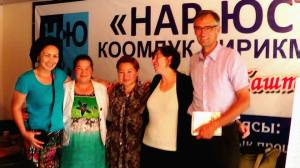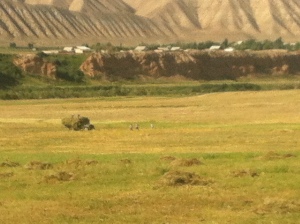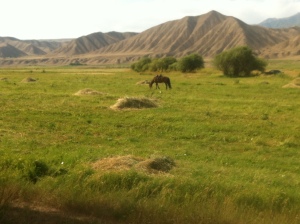I have heard from some of the readers of this blog that my life in Kyrgyzstan seems to be all about having fun and frolicking in the outdoors. While I am all about having fun and frolicking, I want to assure those of you who are US taxpayers (and thus funding my current adventure at a very modest level) that I am doing work here.
My primary assignment is with Nar-Just, an NGO that works to promote the rule of law and to develop civil society in Kyrgyztan. Here’s a photo of me at work with my colleagues and some Peace Corps staff:
Cholpon, the woman in the middle of the photo is the Director of Nar-Just. She has very good ideas, great commitment to our work, and lots of energy. The woman second from the left in the photo is Kuzjibek, who also works at Nar-Just. She helps develop training materials and publish our journal. We have one other employee, Asel, who is the bookkeeper.
Nar-Just has engaged in many activities since its founding in 2003, from lobbying for veterans, mothers and children, to election monitoring and reporting, to training in peaceful dispute resolution, civil rights and good government. Nar-Just currently publishes a journal for local elected officials that helps them to understand their rights and responsibilities. Those officials are elected, but they are unpaid. They are respected in their communities, but they all have jobs, whether as farmers, business owners or parents. Some cannot read and few have access to the internet. Many do not know about the laws that govern their work, including their rights to budgeted funds and information that they need to represent their constituents effectively. Most of those officials grew up when Kyrgyzstan was part of the Soviet Union and the elected officials, such as they were, just carried out instructions from the Central Party. Representative democracy is a new thing here.
In fact, the current Kyrgyz government, along with the World Bank and other international organizations, have identified the development of civil society in Kyrgyzstan as one of the highest priorities for the country. Without civil society, economic development, education, health promotion, and infrastructure maintenance all become difficult and challenging. Many of the past efforts to support the growth of civil society here have been top down efforts that had mixed results. Nar-Just takes a bottom up approach, empowering citizens and giving their elected representatives the tools that they need to serve their constituents. I really think that it’s the right approach and that organizations like Nar-Just are the keys to Kyrgyzstan’s future.
At any rate, I’m working with Cholpon on a five-year plan to make comprehensive training and essential information available to all elected representatives in Naryn Oblast. The plan also creates a path toward self-sustainability for Nar-Just so that it can continue its important work into the future.
And I’m working with CBT Naryn and Kubat Tours, the two primary tourist organizations in town, to develop and improve the nascent tourism industry here. I’ve been talking with the proprietors of Kubat Tours about sponsoring a national horse games festival here in Naryn. If we can pull something together, we’ll do a trial run in August, then try to make it a really big event next summer. And I’ve met with the local USAID office and plan to start working with them on development projects in September.
So I have been working, appearances to the contrary notwithstanding. (I just play hard too.) My Kyrgyz counterparts work hard and have great ideas. Working together, I think that we can make Kyrgyzstan a little nicer place to live and work. We’re giving it our best shot.

